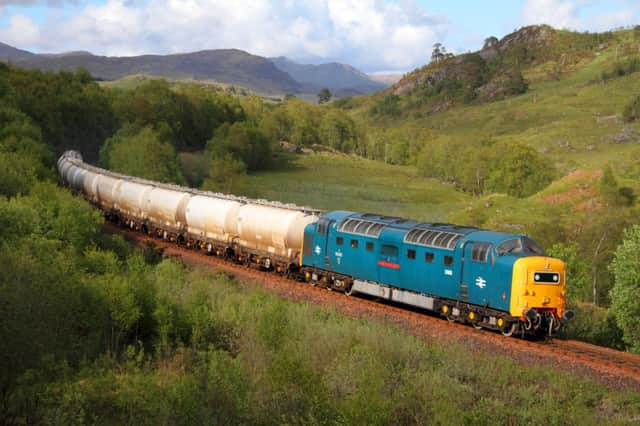Flying Scotsman locomotive back on track


More than 30 years after retiring from 100mph Edinburgh-London expresses, a veteran Deltic engine has returned to Scotland to shuttle ScotRail carriages to refurbishment works.
Such is the dearth of locomotives amid the growth of rail traffic that Royal Scots Grey, with more than three million miles on the clock, is back in service from its home on a heritage railway in England.
Advertisement
Hide AdAdvertisement
Hide AdThe 53-year-old – one of the oldest engines on the Scottish network – is making regular trips in and around Glasgow to take ScotRail’s electric trains to be repainted and maintained because parts of the routes involved are not electrified.
The 3,300hp locomotive, whose engines were developed for naval torpedo boats, also hauls passenger excursions for the Bo’ness-based Scottish Railway Preservation Society.
It has been hired for the work by GB Railfreight, which this month placed its largest ever order for new locomotives. Rail passenger numbers are at a peacetime record high, with freight also increasing.
Industry experts said the firm was using Royal Scots Grey because it had been short of locomotives for some time. Richard Clinnick, assistant editor of Rail magazine, said: “GB Railfreight has had a traction shortage for maybe two years, but recently ordered 21 new locomotives. These start arriving in July.
“The firm doesn’t have enough locos yet to operate the trains that the Deltic is used on. It’s not as ‘green’ as newer locomotives, but it is reliable.”
Deltic Preservation Society chairman Murray Brown said that, despite their age, the locomotives were very versatile.
He said: “A Deltic can run almost anywhere, as it weighs only 99 tons.
“With a shortage of modern motive power, specialised jobs are ideal for this locomotive.”
Advertisement
Hide AdAdvertisement
Hide AdA GB Railfreight spokeswoman said: “At the moment, there is no suitable replacement for the Royal Scots Grey that could undertake this work. Alternative locomotives aren’t in good enough working order to perform this service effectively.”
Managing director John Smith said: “This engine is one of only a few available to perform the task, which it has done reliably for a while now.
“As we continue to invest and grow our fleet, some of our newest locomotives, that we will take delivery of during the summer, are due to be deployed in Scotland.”
The Deltics replaced steam locomotives on the east coast main line in 1961, cutting Edinburgh-London journeys below six hours for the first time.
Royal Scots Grey has since had an illustrious history, hauling the Flying Scotsman train to mark its centenary in 1962 on the day the locomotive received its name at a ceremony at Waverley station in Edinburgh. It was also the last Deltic to front a train on the route in 1982.
The locomotive has also played a part in more recent Scottish milestones, jointly hauling a special train to mark the reopening of the Stirling-Alloa-Kincardine line in 2008.
Royal Scots Grey owner Martin Walker said: “I’ve always thought Deltics were very impressive, and they still have an eye-catching appearance of speed and power.”